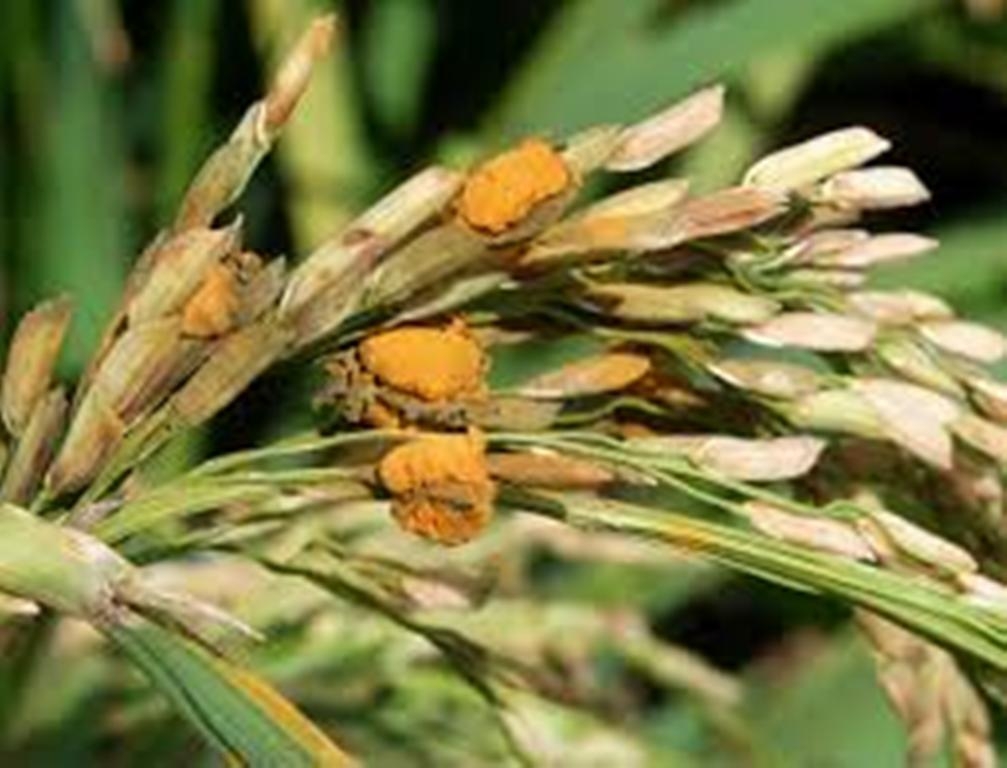
By- Dr Anita Puyam
Brown spot and blast disease of rice has been a major disease affecting rice grain yield in Manipur. However, for the past five to six years, false smut of rice, also known as kambongsatpi in local language, has been emerging as an important disease affecting rice-grain production. The disease has been increasing in an alarming proportion widely in the eastern and north-eastern part of India. It affects the rice panicles causing 44% grain loss (American Phytopathological Society, USA). In damp weather, the disease can be severe. In India, a yield loss of 7-75% was been observed. Unfortunately, the accurate data of yield loss in Manipur due to the disease has not been reported. Among the farmers, the disease has been considered as an omen of good harvest as it appears to be more prevalent in seasons favourable for good growth and high yield. But they must be aware of the threat due to vigorously increasing disease incidence. Understanding the extent of the disease and development of proper management strategies is the need of the time.
The disease is caused by a fungus called “Ustilaginoideavirens”. The major symptom of the disease is the transformation of individual ovaries into large velvety green masses. An irregular round to oval fungal bodies occupied the grains. It causes chalkiness of grains leading to reduction in actual grain weight and also affects seed germination. Not all the spikelets in the ears are affected. The glumes are covered superficially by the green spores. They are covered by a membrane which bursts open in later stage as a result further growth and colour of the ball becomes yellowish green. These spores at maturity become brownish green.
The fungus is both seedborne and soilborne that means the spores can persist on seeds and soil for several years. They also overwinter on collateral host/ alternate hosts on many grasses and wild rice. These spores served as primary inoculums. The infection time is an important factor in determining the loss. If it occurs in early stage of flower opening, the ovary is destroyed and the loss is high whereas if the infection is in the later stage, then the grains set and the mycelium invades the endosperm and produces mass of spores. The disease is favored by rainfall accompanied by cloudy days during the period between flowering and maturity of the grain with RH> 90% and temperature 25-350C. The climatic condition of Manipur is highly suitable for the development of the disease. Therefore, it has been becoming one of the most important diseases of major concerned.
Proper management strategies must be taken up against the disease. Some of the strategies are as follows: i) Sanitation of the field after harvest by removing all the infected seeds, panicles, plant debris, alternate and collateral hosts. The smutted panicles must be wrapped with bags before harvesting, so that the spores are not dispersed.
ii) Since the pathogen is seed borne, heat treatment of the seeds before sowing at 52 0C for 10 min will inhibit the spore germination and prevent infection.
iii) Knowledge regarding up-to-date list of available resistant varieties against the disease must be obtained from local agricultural office.
iv) The disease is susceptible to the plant at hard dough to mature stage of the crops especially during flowering stage. Time of planting must be adjusted, so that the pathogen inoculum doesn’t come in contact with the flowering time during mid-october to mid-november.
v) Since high rate of nitrogen increases the diseases incidence, judicious used of nitrogen in the form of urea is recommended.
vi) Spraying of chlorothalonil (Kavach 2g/l water), copper oxychloride @ 2.5 g/litre or Propiconazole 25EC (Tilt) @ 1.0 ml/litre at boot leaf and milky stages will prevent the fungal infection.
At present, there is a need to understand the importance of this disease and develop all the necessary precautionary measures to prevent yield loss. Till date, less number of resistant varieties against the disease has been released. There is a need to develop more resistant varieties against the disease. Researchers must focus on released of new resistant local varieties that will serve as a boon for the farmers. If the disease is not checked right now, it may take the shape of an epidemic in few years.
The Author, Dr Anita Puyam is a Ph.D. Plant Pathology (Punjab Agricultural University, Ludhiana) presently Teaching as Associate Professor at Rani Lakshmi Bai Central Agricultural University, Jhansi. She can be reached at Email.id-:[email protected]



